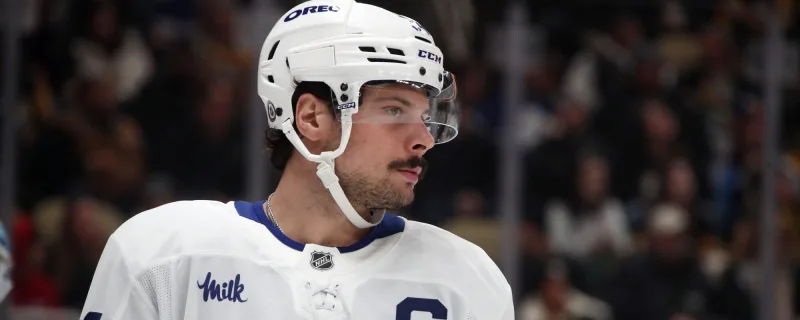
Toronto Maple Leafs captain Auston Matthews was candid about his long-term prognosis after Wednesday’s practice, where he revealed that he’s uncertain if he’ll overcome a lingering upper-body ailment that has kept him out of 15 games this season.
“I don’t know. I hope so,” Matthews said Tuesday, when asked if he felt he’d able to overcome the injury this year. “That’s obviously the goal. It’s tricky with these things sometimes. It’s a physical sport, it’s a contact sport, so things happen out there sometimes that are out of your control. So I’m just trying to manage it as best as I can, and we can, and you just go from there.”
Matthews is Toronto’s best player and raises the team’s ceiling to another tier. Although the Maple Leafs have assembled a collection of top-heavy talent that can rival any team in the league, they aren’t a genuine Cup contender without Matthews. It’s been impressive that the Maple Leafs have remained atop the Atlantic Division while missing Matthews for a third of the year, while fending off myriad other injuries to the forwards corps. Matthews, Calle Jarnkrok and Jani Hakanpaa are the only regular skaters still fighting through long-term injuries — Jarnkrok still hasn’t played in a game this season after undergoing groin and sports hernia surgery in November.
It’s easy to arrive at the conclusion that the Maple Leafs are worse off without their captain, who scored 69 goals during the 2023-24 campaign. How Matthews’ prolonged absence affects the roster on a day-by-day, incremental level is the trickier part. Mitch Marner has elevated his game entirely, tied for 6th in NHL scoring with 51 points prior to Tuesday’s games. William Nylander may become the second consecutive Leaf to win the Rocket Richard, currently ranking second with 23 goals. Joseph Woll and Anthony Stolarz — prior to Stolarz’s injury, where he’s expected to return in late January — provided Toronto with elite goaltending, and now Woll operates alongside Marner as the team’s co-MVP out of necessity. Diminishing returns will set in for the skaters at some point, and this could define the second half of the season for the Maple Leafs.
Marner is playing 21:20 per game, being deployed in all situations while being expected to provide elite playmaking and Selke-level defence. It may be an unreasonable ask, especially if the goal is to keep Marner in optimal form for the playoffs, where all eyes will be on him to finally break through amid a contract year, and a real inflection point for the Core Four overall. John Tavares is amid a resurgent campaign with 18 goals, using his power game and intelligence to elite effect, but eventually, the Maple Leafs may be wise to load manage the 34-year-old forward, who is deployed through all three zones. And the other stark reality: as good as Marner, Nylander and Tavares have been this season, they’re simply going to need more help from the rest of the roster, which may force Brad Treliving to become active at the deadline.
Marner, Nylander, Tavares, Matthews, Matthew Knies and Bobby McMann have accounted for 72.8 percent of Toronto’s goals, and the team ranks dead last in goals scored by defencemen this season. Nick Robertson and Max Domi are out of their slumps, on a new-look third line featuring McMann, but it’s an unsustainable formula. This isn’t the same Maple Leafs team of yesteryear, as Craig Berube has imposed a practical, north-south approach to the game, which minimizes risk and instructs players to protect the net-front at all costs. At some point, the Maple Leafs will need to find some real secondary scoring, which becomes an even greater priority when the best goal-scorer alive is working through a long-term ailment.
Matthews very well could return without further incident this month, but it appears at this juncture that he’ll be fighting through a long-term ailment throughout January and could end up missing the 4 Nations Face-Off. It’s a delicate issue as Matthews clearly wants to play for the United States, while understanding his primary responsibility is attached to leading the Maple Leafs through an extended playoff run. Toronto could place Matthews on long-term injured reserve, if it’s determined that he cannot come back for the regular season, and while it frees up some cap space, the reality is that Matthews, even when he’s not at his best, is still a superior option than any hypothetical replacements — this isn’t to suggest that he should be rushed back, merely that LTIR isn’t a magic wand. And the Maple Leafs, a team that is subject to constant national attention on an off day, along with Matthews, will be under glaring supervision if they exercise this provision.
All parties want Matthews to return to full health, as soon as he can. He’s skated with real velocity and while it was difficult to assess in November, he’s clearly working through a long-term injury, while trying to remain in top shape. Toronto has done an admirable job of remaining competitive without their captain, but the trickle-down effect could be setting in, as the Leafs gear up for a competitive second half of the season, while Marner, Nylander and Woll are more valuable than ever, trying to avoid diminishing returns.
